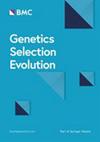模拟小农杂交奶牛群体等位基因品种起源的准确测定
IF 3.1
1区 农林科学
Q1 AGRICULTURE, DAIRY & ANIMAL SCIENCE
引用次数: 0
摘要
准确定位杂合子等位基因(BOA)的品种起源,有助于在杂交育种中引入有弹性或适应性的单倍型。在这项研究中,我们开发并测试了一种确定杂交奶牛个体等位基因来源品种的方法。经过几代本地品种内部和之间的交配以及外来公牛的进口,模拟了五轮选定的杂交奶牛,以模仿中低收入国家(LMICs)的乳制品育种计划。在每一轮选择中,这些杂交动物的等位基因被分阶段分配到它们的品种起源(本地或外来)。在所有的核心长度和相位模式中(偏移-向前移动50%的核心长度或不偏移),正确分配一个品种起源的等位基因的平均百分比为95.76%,只有1.39%的等位基因分配错误,2.85%的等位基因缺失或未分配。经协商一致,正确分配的等位基因平均百分比为93.21%,错误分配的比例仅为0.46%,缺失或未分配的比例为6.33%。这种高比例的等位基因正确分配了品种起源,导致基于核心的平均准确率高达0.99,基于共识(在所有情况下最常见的分配)的平均准确率非常高,为1.00。分配最优匹配阈值的选择影响了算法的分配率和准确率。阈值水平对分配收益和分配准确性有相反的影响。较不严格的阈值产生较高的分配收益和较低的分配准确性。我们开发了一种算法,可以准确地为杂交动物的等位基因分配品种起源,以代表中低收入国家的育种计划。所开发的算法应用简单,不需要预先了解系谱,这使得它更适合中低收入国家的育种计划。本文章由计算机程序翻译,如有差异,请以英文原文为准。
Accurate determination of breed origin of alleles in a simulated smallholder crossbred dairy cattle population
Accurate assignment of breed origin of alleles (BOA) at a heterozygote locus may help to introduce a resilient or adaptive haplotype in crossbreeding. In this study, we developed and tested a method to assign breed of origin for individual alleles in crossbred dairy cattle. After generations of mating within and between local breeds as well as the importation of exotic bulls, five rounds of selected crossbred cows were simulated to mimic a dairy breeding program in the low- and middle-income countries (LMICs). In each round of selection, the alleles of those crossbred animals were phased and assigned to their breed of origin (being either local or exotic). Across all core lengths and modes of phasing (with offset—move 50% of the core length forward or no-offset), the average percentage of alleles correctly assigned a breed origin was 95.76%, with only 1.39% incorrectly assigned and 2.85% missing or unassigned. On consensus, the average percentage of alleles correctly assigned a breed origin was 93.21%, with only 0.46% incorrectly assigned and 6.33% missing or unassigned. This high proportion of alleles correctly assigned a breed origin resulted in a high core-based mean accuracy of 0.99 and a very high consensus-based (most frequently observed assignment across all the scenarios) mean accuracy of 1.00. The algorithm’s assignment yield and accuracy were affected by the choice of threshold levels for the best match of assignments. The threshold level had the opposite effect on assignment yield and assignment accuracy. A less stringent threshold generated higher assignment yields and lower assignment accuracy. We developed an algorithm that accurately assigns a breed origin to alleles of crossbred animals designed to represent breeding programs in the LMICs. The developed algorithm is straightforward in its application and does not require prior knowledge of pedigree, which makes it more relevant and applicable in LMICs breeding programs.
求助全文
通过发布文献求助,成功后即可免费获取论文全文。
去求助
来源期刊

Genetics Selection Evolution
生物-奶制品与动物科学
CiteScore
6.50
自引率
9.80%
发文量
74
审稿时长
1 months
期刊介绍:
Genetics Selection Evolution invites basic, applied and methodological content that will aid the current understanding and the utilization of genetic variability in domestic animal species. Although the focus is on domestic animal species, research on other species is invited if it contributes to the understanding of the use of genetic variability in domestic animals. Genetics Selection Evolution publishes results from all levels of study, from the gene to the quantitative trait, from the individual to the population, the breed or the species. Contributions concerning both the biological approach, from molecular genetics to quantitative genetics, as well as the mathematical approach, from population genetics to statistics, are welcome. Specific areas of interest include but are not limited to: gene and QTL identification, mapping and characterization, analysis of new phenotypes, high-throughput SNP data analysis, functional genomics, cytogenetics, genetic diversity of populations and breeds, genetic evaluation, applied and experimental selection, genomic selection, selection efficiency, and statistical methodology for the genetic analysis of phenotypes with quantitative and mixed inheritance.
 求助内容:
求助内容: 应助结果提醒方式:
应助结果提醒方式:


